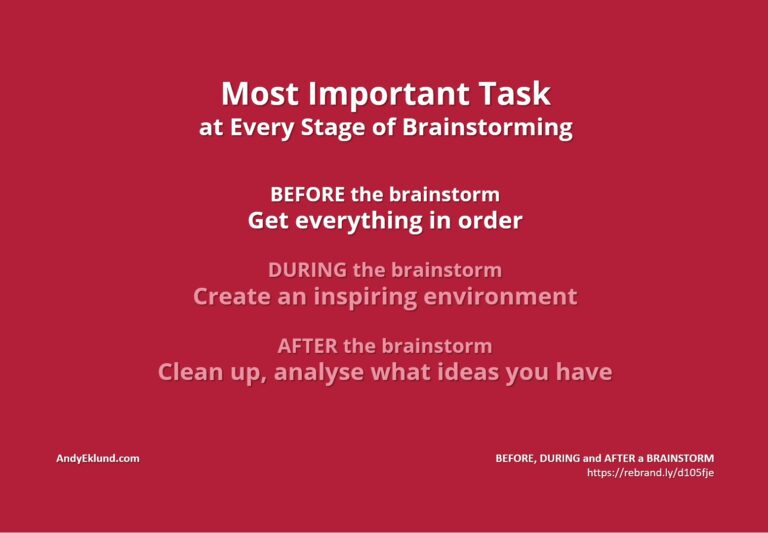This article begins a three-part series on the basics of brainstorming, organised by what to do …
Before the Brainstorm
During the Brainstorm (click here)
After the Brainstorm (click here)
While these lists may seen extensive, pick and choose what makes sense based on the size of the project, the team of people, how much time you may have, and any other consideration specific to your organisation or situation.
No. 1 Task for BEFORE the brainstorm: Get everything in order (prepare)
Here are the basic tasks with relevant links to my own and others’ sources to help you get organised before the brainstorm begins.
Step 1: Determine the purpose of the brainstorm, as well as the specific problem the idea is meant to solve.
What goal are you trying to achieve or accomplish?
Are there specific problems you trying to overcome or address?
Most of all, do you agree with the key decision maker, meeting sponsor or client on the purpose of the brainstorm?
For more, try Defining the Problem.
Step 2: Use a creative problem-solving process
The most well-known creative process was developed by Graham Wallas in The Art of Thought (1926) as a four-step process, before eventually becoming the five-step process below .
- Preparation: Gather information and data
- Incubation: Develop potential ideas, often by physically or mentally getting away from the problem, using unconscious or subconscious thinking by doing something/anything else
- Illumination: The point of ! when the best idea(s) moves from potential idea to specific action
- Evaluation: Will the idea do we need it to do?
- Implementation: Roll-out the idea, measure and finish.
- From Genially Blog:
- From IdeaPod: The Creative Process: To Improve Your Creativity, Follow These 5 Steps
- From The Interaction Design Foundation:
Step 3: Conduct research
Gather information about the topic, the objective, the problem, the business or societal environment, and the target audience. What key insights can be drawn from this information? And, how can this insight be leveraged by turning it into an idea?
For more, try: How Information Becomes Ideas (The Information Chain)
Step 4: Invite a diverse group of people to brainstorm the problem
Six to eight people are ideal, comprising of 1) prolific idea people, 2) people who fit the target profile, 3) people with knowledge of the core problem, the issues or the audience, and 4) one or two core team members. If possible, try to invite “outsiders” – people who aren’t directly connected to the topic.
For more, try: Inviting the Right People to a Brainstorm
Step 5: Distribute the brief to the brainstorm participants
In addition to following a creative process, a good strategy or creative brief might include a pre-brainstorm exercise or an encouragement to think privately before the brainstorm. RSVP to make sure your invitees are coming.
For more, try: The Creative Brief
Step 6: Prepare the brainstorm environment
Going out is usually better, but if you must stay in, do whatever you can to “energise” the space with games, toys, colourful pictures, mood boards. Gather tools and sort out the equipment, such as flip-charts and paper, markets, creative exercises.
Also, try any articles under the Category of Games & Exercises
Step 7: Designate a good facilitator to conduct the brainstorm
A good facilitator 1) understands the CPS process, 2) engages a group in a balanced discussion, 3) sees the forest from the trees, 4) know tips, tools and exercises to inspire the group, 5) is passionate and independent.
For more, try: Do You Need a Brainstorm Facilitrator?
Step 8: Determine how you will select the best ideas
What criteria will you use to choose the best ideas? Some criteria are linked with the objective, the central problem, issues or strategies.
For examples, try: Creative Critieria
Step 9: Don’t loose time
If time is of the essence, don’t loose time confirming the first eight steps. Start brainstorming immediately so you have as many ideas as possible. BUT, do NOT pre-maturely select the ideas until you have the best quality information to choose the right ideas.
Any other thoughts on things to do prior to the brainstorm? Please add your thoughts and comments below.



No comment yet, add your voice below!